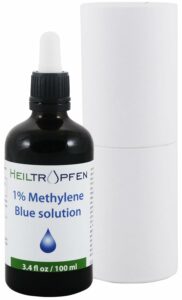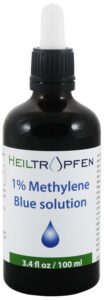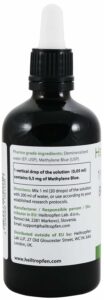What I Think of Methylene Blue: The Mitochondrial “Blueprint” for Energy & Brain Health (And Why It’s Not a Miracle Cure)
Spoiler: This Blue Dye Fueled My Deep Dive into Longevity Science – Here’s What I Learned
Methylene blue (MB) isn’t new – it’s been used for malaria, dyeing jeans, and even staining microscope slides since 1876. But lately, it’s gone viral in biohacking circles as a “mitochondrial energizer” and cognitive enhancer. As someone obsessed with longevity science, I dove into the research (including this study) to separate hype from reality. Here’s my take on Heiltropfen®’s Methylene Blue 1% Solution – and why it’s not a quick fix.
👉 Find Heiltropfen® Methylene Blue on Amazon (Research Use Only)



MB is a synthetic compound that acts as a mitochondrial electron cycler, helping cells produce energy (ATP) more efficiently. Think of it as a “jumpstart” for your cellular batteries. Studies like this 2017 PMC review highlight its potential for:
- Enhancing mitochondrial respiration (energy production)
- Reducing oxidative stress (antioxidant properties)
- Supporting cognitive function (neuroprotection)
But let’s be clear: This product is labeled for research use, not human consumption. Always consult a doctor before experimenting.
Potential Health Benefits (What the Research Says)
1. Mitochondrial Energy Boost: Fact or Fiction?
MB’s best-studied role is improving mitochondrial efficiency. By shuttling electrons in the cellular energy cycle, it may:
- Reduce fatigue in cells under stress (e.g., aging, inflammation).
- Enhance physical endurance – a 2020 rodent study showed increased running capacity.
My take: For biohackers, low-dose MB (0.5–4 mg/kg) might support energy, but human trials are limited.
2. Brain Health & Cognitive Support
The PMC study notes MB’s ability to:
- Protect neurons from oxidative damage.
- Improve memory in animal models of Alzheimer’s.
- Act as a mild MAO inhibitor, potentially aiding mood (but conflicting evidence).
My caution: Self-dosing for brain health is risky. MB interacts with SSRIs (risk of serotonin syndrome).
3. Cancer Research: A Glimmer of Hope?
MB is being studied for photodynamic cancer therapy (using light to target tumors), but:
- It’s not a standalone cure.
- Most research is preclinical (lab/animal models).
Bottom line: Promising, but far from proven.
How to Use Methylene Blue (If You Insist)
The Heiltropfen® solution contains 1% MB (0.5 mg per drop). The label advises:
- Research use only.
- Mix 1 ml (20 drops) with 200 ml water – but this is not medical advice.
If prescribed by a doctor, typical low doses range from 0.5–2 mg/kg daily. For a 70kg person:
- 0.5 mg/kg = 35 mg = ~70 drops (3.5 ml) of this solution.
- Start low (e.g., 1–2 drops daily) to assess tolerance.
Risks & Side Effects
- Serotonin Syndrome: MB inhibits MAO enzymes. Never mix with SSRIs (e.g., Prozac), opioids, or stimulants.
- Urine/Stool Discoloration: Harmless but alarming (you’ll pee blue).
- Overdose Risks: High doses (>7 mg/kg) can cause nausea, dizziness, or anemia.
My Final Thoughts
Methylene blue fascinates me as a research tool, but it’s not a magic bullet. While studies suggest benefits for mitochondrial health and cognition, self-experimentation is risky. If you’re still curious:
- Consult a functional medicine doctor for dosing guidance.
- Buy third-party tested products like Heiltropfen® (this one’s USP-grade).
- Never use it “just because” – respect its potency.


